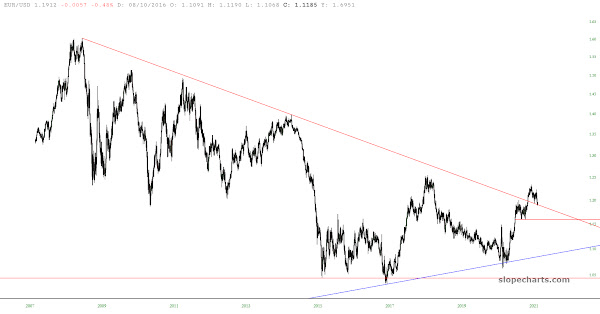EURUSD is arguably the most important chart in the world right now and will be as long as the candles are below the red line. Below the line the "good" inflation narrative runs into trouble. Expansions funded by credit growth weakens the U.S. dollar because as the reserve currency, the system expands on dollar credit. Global growth withn the current economic structure should lower the dollars exchange rate.
When the system stalls like it did in 2008, growth is suppressed. Many charts will express this, but EURUSD is as good as any. In 2008, peoople were talking about hyperinflation and the death of the dollar. Oil was $150 a barrel. Then came QE. That was going to cause hyperinflation. EURUSD heads back up towards that resistance line in late 2009. The in 2011 it tries again, but that was the point where most commodities aside from oil began precipitious declines. Inflation hopes revive in 2014. China is going to take over! Nope. The U.S. Dollar bull market began one month later. Oil started tumbing. The yuan would devalute 15 months later from that touch of the line (it forms the resistance, being the second point in the line). Inflation hopes (fears?) revive in 2018. Nope. They come back again in 2020 and into early 2021. This has to be the time right? "Everyone" realizes there will be no inflation from the banking system. Borrowers are streched. Weak demand for credit is exceedeed by even weaker willingness to lend. This time is supposed to be different though. I don't use that term pejoratively, as when it is used at stock market peaks. There's a legitimate question at these turning points. Is this time different? Will the 40-year bond bull market finally end? The assumption is government will be the borrower of last resort.Maybe this time isn't different, but the same as any other growth cycle. The U.S. Dollar Index has roughly 6-year cycles of bear, consolidation, bull. By the cycle clock, the U.S. dollar peaked on time in March 2020. On that note, I have yet to see a dollar bear forecast that substantially exceeds the first two years of the last two dollar bear markets in 1985 and 2002. A weaker dollar could signal this cycle is possibly underway before it shows up in lending data. Loan data will be negative year-on-year starting in two weeks, that is the total value of loans measured by indexes such as total loans and leases (TOTLL at FRED) will be below where it was last March. Year-over-year credit growth bottomed after the recession ended in the previous expansions. The problem after 2008 was credit growth never saw a sustainable rise. There was a pop in private lending about 6 years ago, but the government was not runnng up deficits. Now the deficit has soared, but private lending hasn't followed yet.
As the charts above show, U.S. government borrowing pushed total credit growth to levels on par with the inflationary 1970s and 2000s. If deficits remain large and private borrowing picks up, then perhaps a government-pushed growth cycle will kick off. This would be an inflationary-growth cycle, with a substantial portion of credit going into productive uses. Simlar to the 2000s housing and financial bubble coming alongside real growth in various sectors and emerging markets, led by China. The U.S. dollar stays on cycle and the next bull market starts in 2032. Or doesn't, and then we can seriously consider the U.S. dollar losing it's status as the main reserve currency.Going back to EURUSD. The greenback shouldn't be rising beyond a short-term rally. The prior bear markets didn't see much in the way of counter-trend rallies this soon. That said, DXY needs to clear 96 before the bear market is thrown into question and it has to cross 100 to open up the possibility that something is indeed different this time. It would also be surprising if the dollar turns and the Nasdaq keeps rising. Turns in the dollar have been followed by economic shocks and changes in asset leadership. A stock market crash, real estate bust and S&L crisis followed the 1985 peak. The mid-1990s dollar bull market took down Southeast Asia, Russia and commodities. The tech bust led the turn in 2002. The dollar bottom in 2008 needs no description. The 2014 bull market wrecked commodities and gave China continual headaches, to the point where it closed its capital account to defend the yuan. We also saw tech lead in what I consider quite a parallel with the late 1990s. The peak in 2020 accompanied the coronavirus pandemic and lockdowns. The turn lower will now trigger what? Destruction of the stock bubble and creation of a commodities bubble is the generally accepted narrative, and one I'd rather be positioned for than against at this point. With the caveat that if there's a full-blown bear market, there will be better entry points for commodities, but perhaps no better time to be selling big-cap sector index tech than the present.










No comments:
Post a Comment